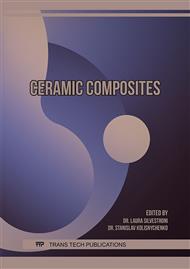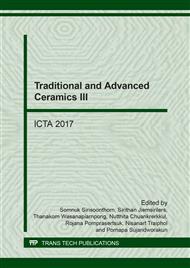p.233
p.241
p.246
p.252
p.258
p.264
p.270
p.276
p.282
Dielectric Properties and Microstructural Studies of Er2O3 Doped Potassium Sodium Niobate Silicate Glass-Ceramics
Abstract:
In this work, electrical and structural properties of ferroelectric glasses and glass-ceramics from K0.5Na0.5NbO3-SiO2 doped with 0.5-1.0 mol%Er2O3 system have been investigated. The influent of Er2O3 dopant was also compared with the original glass. The K0.5Na0.5NbO3 (KNN) powder was mixed with SiO2 in composition of 75KNN-25SiO2 and doped with Er2O3. Well-mixed powder was subsequently melted at 1300°C for 15 min in a platinum crucible using an electric furnace. The quenched glasses were then subjected to heat treatment at various temperatures for 4 h. From the study, KNN single phase in transparent glass was successfully prepared via incorporation method. The maximum Ԑr of about 360 at 10 kHz with a low tanδ of 0.07 could be obtained from the glass-ceramic sample of 75KNN–25SiO2 doped 0.5 mol% Er2O3 and heat treated at 600°C. It can be seen that the higher percent of Er2O3 can lower the dielectric loss of KNN glass-ceramics. This interesting value suggesting the opportunity of using them in electronic applications in the future.
Info:
Periodical:
Pages:
258-263
Citation:
Online since:
April 2018
Keywords:
Price:
Сopyright:
© 2018 Trans Tech Publications Ltd. All Rights Reserved
Share:
Citation:



